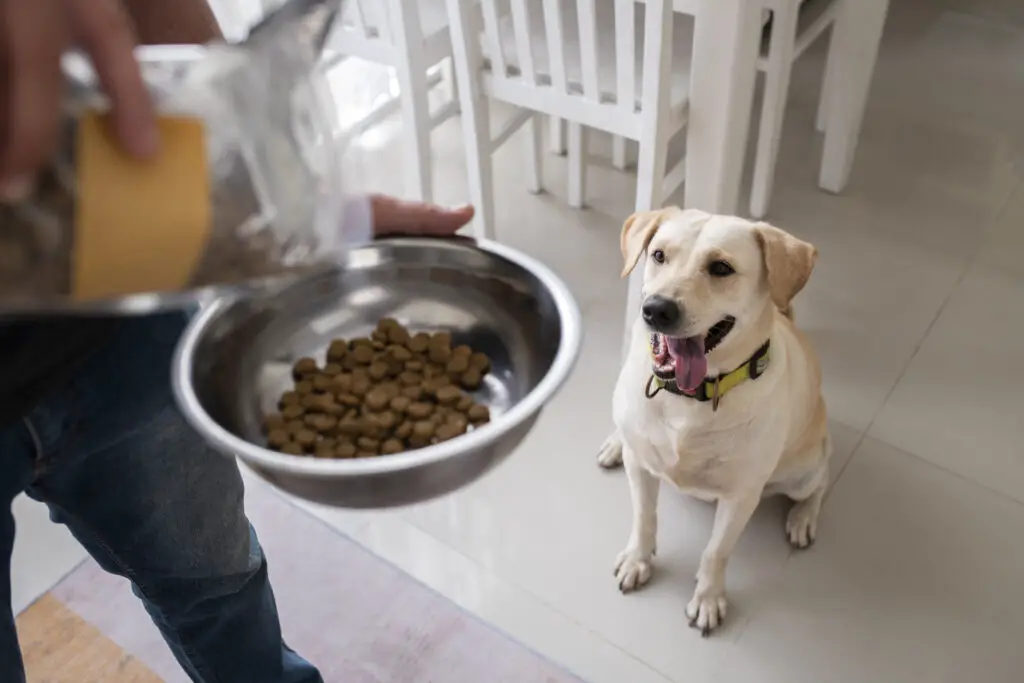If you’re a dog owner, you probably want to provide the best care for your pet dog, including the right amount of food. Measuring dog food can be a bit confusing, especially when recipes or feeding guides mention measurements in pounds, but you only have a measuring cup on hand. Know how many cups of dog food are in a pound here.
In this comprehensive guide, we will explore how many cups of dog food are in a pound. We will also address common questions about dog food measurements, ensuring you can provide your pet dog with the right amount of nutrition.
How Many Cups of Dog Food in a Pound?

The conversion between cups and pounds of dog food depends on the type and density of the food. Different brands and formulations may have varying measurements.
However, as a general guideline, there are approximately 4 cups of dry dog food in a pound. This estimation may vary slightly based on factors such as the kibble’s size and shape, but it serves as a practical starting point for most dog owners.
Feeding Guidelines Based on Your Dog’s Weight
Different dogs have different dietary requirements based on their size, activity level, and metabolism. Here’s a helpful feeding guide to ensure your furry companion receives the right amount of nutrition:
1. Small Breeds (Up to 20 lbs)
Small dog breeds have faster metabolisms and, therefore, require more calories per pound of body weight. On average, they need about 40 calories per pound. So, a 10-pound small breed dog would require approximately 400 calories per day, which is around 1 cup of dry dog food.
2. Medium Breeds (20-50 lbs)
Medium-sized dogs have moderate energy levels and need about 30 calories per pound. For example, a 30-pound medium breed dog would need around 900 calories daily, equivalent to approximately 2.5 cups of dry dog food.
3. Large Breeds (50-100 lbs)
Larger breeds tend to have lower energy needs per pound and need about 20 calories per pound. A 70-pound large breed dog would require around 1400 calories daily, which translates to approximately 3.5 cups of dry dog food.
4. Giant Breeds (Over 100 lbs)
Giant dog breeds have slower metabolisms and typically need 15 calories per pound. For instance, a 120-pound giant breed dog would require approximately 1800 calories per day, equivalent to about 4.5 cups of dry dog food.
Factors to Consider for Proper Feeding:
- Dog’s Size and Age: Larger dogs and puppies have different nutritional needs compared to smaller or adult dogs. Consider the appropriate serving size based on your dog’s size and life stage.
- Activity Level: Active dogs may require more food to meet their energy needs, while less active dogs might need a smaller portion to prevent weight gain.
- Breed and Metabolism: Certain breeds may have different metabolism rates, affecting how much they should be fed.
- Health Conditions: If your dog has any health conditions, consult with your veterinarian to determine the best feeding plan.
- Dog Food Density: The density of dog food plays a significant role in determining the number of cups in a pound. Different formulas and ingredients can result in varying densities. For instance, high-protein or grain-free diets might be denser than regular formulas. Always check the packaging for specific feeding guidelines.
Measuring Dog Food: Tips and Techniques

- Use a Standard Measuring Cup: Invest in a measuring cup specifically designed for pet food, as it ensures accurate measurements.
- Level the Cup: When measuring dry food, level off the cup with a straight edge to avoid over or under-feeding.
- Keep Track of Treats: Remember to include treats and snacks in your dog’s daily food intake to maintain a balanced diet.
- Avoid Overfeeding: Obesity is a common health issue in dogs, so ensure you’re not overfeeding your furry friend.
- Use a Kitchen Scale: When precision matters, a kitchen scale is your best friend. Weighing the food in pounds eliminates any guesswork and ensures you provide your dog with the exact amount they need. Divide the total weight by 4 to get the approximate number of cups.
Tips for Switching Dog Food Brands or Types:

- Gradual Transition: When switching your dog’s food, do it gradually over several days to avoid digestive upset.
- Observe Your Dog: Keep a close eye on your dog’s reaction to the new food to ensure it agrees with them.
- Read Feeding Guidelines: Follow the manufacturer’s feeding guidelines to ensure your dog receives the right amount of nutrition
How Many Cups of Dog Food in a Pound for Different Brands?

It’s necessary to note that different dog food brands can have varying densities, affecting the number of cups in a pound. Always refer to the packaging for specific feeding guidelines. Here are a few examples:
| Brand | Cups of Food in 1 Pound |
|---|---|
| Brand X | 3.5 Cups |
| Brand Y | 4.2 Cups |
| Brand Z | 3.8 Cups |
Frequently Asked Questions (FAQs):
Can I Mix Different Brands of Dog Food?
Switching dog food brands should be done gradually over several days to avoid digestive issues. However, mixing different brands can be done as long as your dog tolerates it well.
My Dog Is a Picky Eater. What Should I Do?
If your dog is a picky eater, try offering different flavors or textures of food. You can also consult your veterinarian for personalized advice.
How Can I Store Dog Food Properly?
To maintain the food’s freshness and quality, store it in a cool, dry place, preferably in an airtight container. Avoid exposing the food to direct sunlight or extreme temperatures.
How often should I feed my dog?
Puppies require more frequent feeding (3-4 times a day), while adult dogs can be fed twice a day.
Can I use a regular measuring cup for dog food?
It’s best to use a measuring cup specifically designed for pet food to ensure accurate portions.
Is wet or dry dog food better?
Both types can be nutritious, but dry food is more convenient and helps maintain dental health.
Can I free-feed my dog?
Free-feeding can lead to overeating and obesity. It’s better to stick to scheduled meal times.
How do I calculate the right portion size for my dog?
Consider your dog’s weight, age, activity level, and follow the manufacturer’s guidelines.
Should I consult my vet about my dog’s diet?
Yes, your veterinarian can provide personalized advice based on your dog’s specific needs.
Can I Mix Wet and Dry Dog Food Together?
The short answer is, yes, you can mix wet and dry dog food together. In fact, many pet owners opt for this approach as it offers certain benefits to both the dog and the owner. However, it’s essential to do it right and understand the dos and don’ts to ensure your dog’s nutritional needs are met adequately.
Conclusion:
Understanding the conversion from pounds to cups for dog food is essential for providing the right nutrition to your furry companion. Remember to consider factors like your dog’s size, age, activity level, and health conditions when determining the appropriate portion size.
Always follow the feeding guidelines provided by the dog food manufacturer and consult your veterinarian for personalized advice. With the proper knowledge, you can ensure your beloved dog enjoys a healthy and balanced diet.


